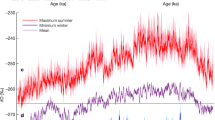Abstract
Arising from T. Laepple, M. Werner & G. Lohmann Nature 471, 91–94 (2011)10.1038/nature09825; Laepple et al. reply
The resemblance of the orbitally filtered isotope signal from the past 340 kyr in Antarctic ice cores to Northern Hemisphere summer insolation intensity has been used to suggest that the northern hemisphere may drive orbital-scale global climate changes1. A recent Letter2 by Laepple et al. suggests that, contrary to this interpretation, this semblance may instead be explained by weighting the orbitally controlled Antarctic seasonal insolation cycle with a static (present-day) estimate of the seasonal cycle of accumulation. We suggest, however, that both time variability in accumulation seasonality and alternative stable seasonality can markedly alter the weighted insolation signal. This indicates that, if the last 340 kyr of Antarctic accumulation has not always looked like the estimate of precipitation and accumulation seasonality made by Laepple et al.2, this particular accumulation weighting explanation of the Antarctic orbital-scale isotopic signal might not be robust.

Similar content being viewed by others
References
Kawamura, K. et al. Northern Hemisphere forcing of climatic cycles over the past 360,000 years implied by accurately dated Antarctic ice cores. Nature 448, 912–916 (2007)
Laepple, T., Werner, M. & Lohmann, G. Synchronicity of Antarctic temperatures and local solar insolation on orbital timescales. Nature 471, 91–94 (2011)
Parrenin, F. et al. The EDC3 chronology for the EPICA Dome C ice core. Clim. Past 3, 485–497 (2007)
Sime, L. C., Wolff, E. W., Oliver, K. I. C. & Tindall, J. C. Evidence for warmer interglacials in East Antarctic ice cores. Nature 462, 342–345 (2009)
Sime, L. C. et al. Antarctic isotopic thermometer during a CO2 forced warming event. J. Geophys. Res. 113, D24119 (2008)
Jouzel, J. et al. Orbital and millennial Antarctic climate variability over the last 800,000 years. Science 317, 793–796 (2007)
Petit, J. R. et al. Climate and atmospheric history of the past 420,000 years from the Vostok ice core, Antarctica. Nature 399, 429–436 (1999)
Paul, A. & Schäfer-Neth, C. Gridded Global LGM SST and Salinity Reconstruction. IGBP PAGES/World Data Center for Paleoclimatology, Boulder Data Contribution Series 2003–046 (NOAA/NGDC Paleoclimatology Program, 2003)
Paul, A. & Schäfer-Neth, C. Modeling the water masses of the Atlantic Ocean at the Last Glacial Maximum. Paleoceanography 18, 1058 (2003)
Author information
Authors and Affiliations
Contributions
L.C.S. conducted the original model simulations, carried out the insolation weighting calculations, and co-wrote the manuscript. E.W.W. motivated the work and co-wrote the paper.
Corresponding author
Ethics declarations
Competing interests
Competing financial interests: declared none.
PowerPoint slides
Rights and permissions
About this article
Cite this article
Sime, L., Wolff, E. Antarctic accumulation seasonality. Nature 479, E1–E2 (2011). https://doi.org/10.1038/nature10613
Published:
Issue Date:
DOI: https://doi.org/10.1038/nature10613
- Springer Nature Limited
This article is cited by
-
Model evidence for a seasonal bias in Antarctic ice cores
Nature Communications (2018)
-
Laepple et al. reply
Nature (2011)





